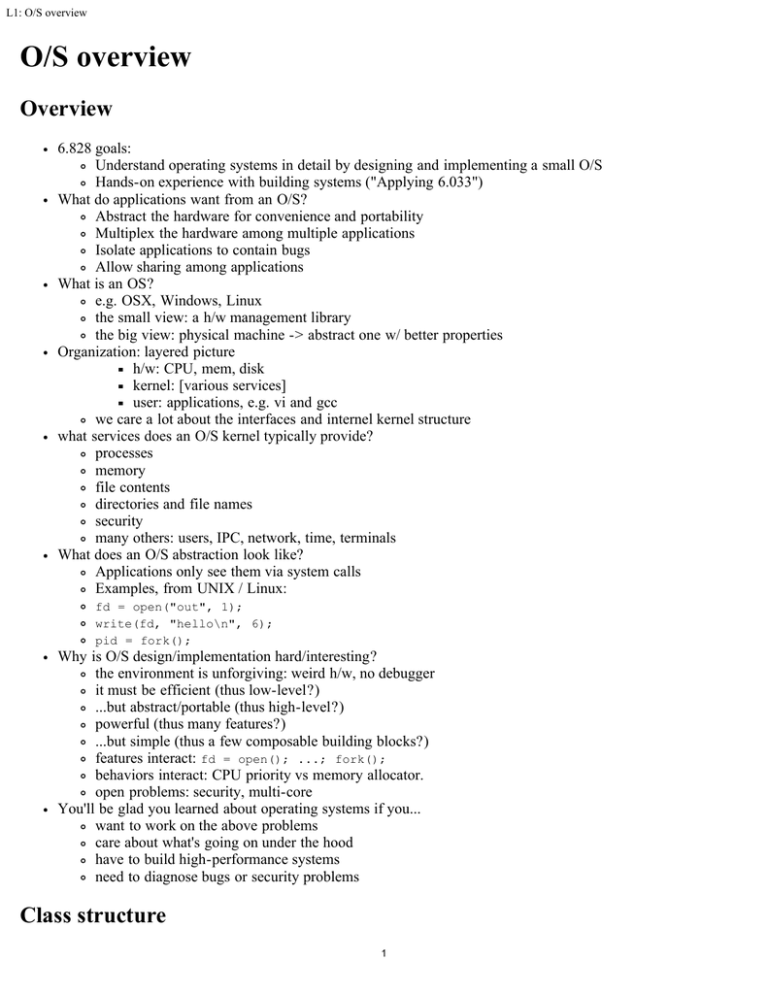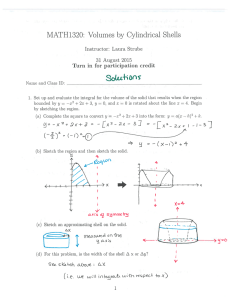O/S overview Overview
advertisement

L1: O/S overview
O/S overview
Overview
6.828 goals:
Understand operating systems in detail by designing and implementing a small O/S
Hands-on experience with building systems ("Applying 6.033")
What do applications want from an O/S?
Abstract the hardware for convenience and portability
Multiplex the hardware among multiple applications
Isolate applications to contain bugs
Allow sharing among applications
What is an OS?
e.g. OSX, Windows, Linux
the small view: a h/w management library
the big view: physical machine -> abstract one w/ better properties
Organization: layered picture
h/w: CPU, mem, disk
kernel: [various services]
user: applications, e.g. vi and gcc
we care a lot about the interfaces and internel kernel structure
what services does an O/S kernel typically provide?
processes
memory
file contents
directories and file names
security
many others: users, IPC, network, time, terminals
What does an O/S abstraction look like?
Applications only see them via system calls
Examples, from UNIX / Linux:
fd = open("out", 1);
write(fd, "hello\n", 6);
pid = fork();
Why is O/S design/implementation hard/interesting?
the environment is unforgiving: weird h/w, no debugger
it must be efficient (thus low-level?)
...but abstract/portable (thus high-level?)
powerful (thus many features?)
...but simple (thus a few composable building blocks?)
features interact: fd = open(); ...; fork();
behaviors interact: CPU priority vs memory allocator.
open problems: security, multi-core
You'll be glad you learned about operating systems if you...
want to work on the above problems
care about what's going on under the hood
have to build high-performance systems
need to diagnose bugs or security problems
Class structure
1
L1: O/S overview
http://pdos.lcs.mit.edu/6.828
Lectures
basic O/S ideas
extended inspection of xv6, a traditional O/S
several more recent topics
in-class programming
Lab: JOS, a small O/S for x86 in an exokernel style
you build it, 5 labs, final project of your choice
kernel interface: expose hardware, but protect -- no abstractions!
unprivileged library: fork, exec, pipe, ...
applications: file system, shell, ..
development environment: gcc, qemu
lab 1 is out
Code review
One quiz: in class
No final, but project and project conferences
Case study: the shell (simplified)
6.828 is largely about design and implementation of system call interface. let's start by looking at how programs
use that interface. example: the Unix shell.
the shell is the Unix command UI
the shell is also a programming/scripting language
typically handles login session, runs other processes
look at some simple examples of shell operations, how they use different O/S abstractions, and how those
abstractions fit together. See 'The UNIX Time-Sharing System' by D. M. Ritchie and K. Thompson if you are
unfamiliar with the shell.
Basic structure: see sh.c
Basic organization: parsing and executing commands (e.g., ls, ls | wc, ls > out)
Shell implemented using system calls (e.g., read, write, fork, exec, wait) conventions: -1 return value signals
error, error code stored in errno , perror prints out a descriptive error message based on errno .
Many systems calls are encapsulated in libc calls (e.g., fgets vs read)
what does fork() do?
copies user memory
copies process kernel state (e.g. user id)
child gets a different PID
child state contains parent PID
returns twice, with different values
what does wait() do?
waits for any child to exit
what if child exits before parent calls wait?
What does parscmd() do?
Example:
$ ls
The parse functions form a simple recursive-descent parser for the sh scripting language
Do exercise 1 of Shell Exercises for Lecture 1
You need a variant of exec() (type "man 3 exec"):
replaces memory of current process with instrs/data from file
i.e. runs a file created by compiler/linker
still the same process, keeps most state (e.g. user id)
the fork/exec split looks wasteful, but it turns out to be useful.
how does "ls" know which directory to look at?
cwd in kernel-maintained process state, copied during fork
2
L1: O/S overview
how does it know what to do with its output?
I/O: process has file descriptors, numbered starting from 0.
index into table in process's kernel state
system calls: open, read, write, close
numbering conventions:
file descriptor 0 for input (e.g., keyboard). fgets(stdin) invokes:
read (0, buf, bufsize)
file descriptor 1 for output (e.g., terminal). fprintf(stdout) invokes:
write (1, "hello\n", strlen("hello\n"))
file descriptor 2 for error (e.g., terminal)
so ls writes output to file descriptor 1
on fork, child inherits open file descriptors from parent (show in process diagram).
on exec, process retains file descriptors.
This shell command sends ls's output to the file out:
$ ls > out
Q: how could our simple shell implement output redirection?
A: Do exercise 2.
Good illustration of why it's nice to have separate fork and exec.
Many commands use 0/1 by default, so they work with redirection. For example, see xv6 cat.c.
system call interface simple, just ints and char buffers. why not have open() return a pointer reference to a
kernel file object?
Linux has a nice representation of a process and its FDs, under /proc/PID/
maps: VA range, perms (p=private, s=shared), offset, dev, inode, pathname
fd: symlinks to files pointed to by each fd. (what's missing in this representation?)
try exec 3>/tmp/xx ; ls -l /proc/$$/fd
One often wants to run a series of programs on some data:
$
$
$
$
sort < in > out
uniq out > out2
wc out2
rm out out2
the shell supports this more concisely with "piping" of "filters":
$ sort < in | uniq | wc
A pipe is a one-way communication channel. Here is a simple example:
int fds[2];
char buf[512];
int n;
pipe(fds);
write(fds[1], "hello", 5);
n = read(fds[0], buf, sizeof(buf));
// buf[] now contains 'h', 'e', 'l', 'l', 'o'
file descriptors are inherited across fork(), so this also works:
int fds[2];
char buf[512];
int n, pid;
pipe(fds);
pid = fork();
if(pid > 0){
write(fds[1], "hello", 5);
} else {
n = read(fds[0], buf, sizeof(buf));
exit(0);
}
3
L1: O/S overview
How does the shell implement pipelines (i.e., cmd 1 | cmd 2 |..)? We want to arrange that the output of cmd 1 is
the input of cmd 2. The way to achieve this goal is to manipulate stdout and stdin.
The shell creates processes for each command in the pipeline, hooks up their stdin and stdout, and waits for the
last process of the pipeline to exit.
Do exercise 3.
Who waits for whom? (draw a tree of processes)
Why close read-end and write-end? ensure that every process starts with 3 file descriptors, and that reading from
the pipe returns end of file after the first command exits.
You can run the shell, redirect its stdin/stdout, etc.
I'll run this shell script with sh < script:
echo one
echo two
Q: what will this shell command do?
$ sh < script > out
the script itself didn't redirect the echo output, but it did inherit a fd 1 that was redirected to out.
Q: I'll run the following directly; is it the same as above?
echo one > out
echo two > out
Notes about the file descriptor design:
nice interaction with fork
FDs help make programs more general purpose: don't need special cases for files vs console vs pipe
shell pipelines only work for programs w/ common formats (lines of text)
How do you create a background job?
$ sleep 2 &
Q: How does the shell implement "&"?
Q: What if a background process exits while sh waits for a foreground process?
Do challenge exercises
4
MIT OpenCourseWare
http://ocw.mit.edu
6.828 Operating System Engineering
Fall 2012
For information about citing these materials or our Terms of Use, visit: http://ocw.mit.edu/terms.



